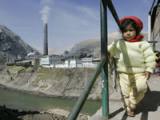Milagros Salazar* – Tierramérica
LIMA, Aug 10 2007 (IPS) – Far from halting the source that is poisoning the Andean city of La Oroya, which is home to the Doe Run smelting complex, the Peruvian government ordered a contingency plan for the days when air pollution is worst, as if it were dealing with a natural disaster.

The toxic air of La Oroya is a time bomb for the city's children. Credit: Courtesy of Peruvian newspaper La República
The Contingency Plan for States of Alert will be presented Aug. 10 by the government s national environmental council, CONAM, which approved it Jul. 18 to protect the 35,000 inhabitants of La Oroya from the sulphur dioxide, lead and cadmium emissions from the Doe Run smokestacks.
The plan is the result of two years of debates involving citizen groups, non-governmental organisations and the state agencies in charge of carrying it out, as well as representatives of the company, which will provide much of the financing.
La Oroya, 180 kilometres east of Lima, is one of the country s 13 most polluted cities, the government said in 2001. The New York-based Blacksmith Institute in 2006 included it in a list of the 10 worst cases in the world.
CONAM regional coordinator Carlos Rojas told Tierramérica there will be three levels of alert: watch, danger and emergency, according to which actions will be taken to limit the exposure of the affected population and partially halt two production lines of lead and copper at Doe Run.
The degree of alert will be determined based on air quality and weather forecasts unfavourable to dispersal of the gases and particulates away from the city, such as lower temperatures and lack of wind. But none of the three levels entails ceasing operations at the smelting plant, Rojas said.
Related IPS Articles
Once a state of alert is ordered, it will be recommended that the most vulnerable children, pregnant women, the elderly and people with respiratory or cardiovascular illnesses should not be outdoors between 9:00 am and 1:00 pm local time, the worst period of the day for exposure.
Doors and windows of homes, schools and hospitals should be closed, and food sold on the street should be covered.
The population in general should cover mouth and nose with scarves and handkerchiefs when outside. The idea of facemasks was ruled out because people don t want images that further dramatise the situation, said Rojas.
Asked about Doe Run s contribution to the contingency plan, a company source told Tierramérica that it has been applying stop-work measures voluntarily since 2000.
The stoppages affect two plants identified as the ones producing the greatest volume of sulphur dioxide: sintering (to produce bullion) and copper conversion. In the first case, reducing the input of sulphur, and in the second, halting one or several copper foundries, according to the company.
But the cost of the actions involved in the implementation of the contingency plan for each of the actors involved has not yet been determined, said the source.
The gases and particulate matter affect people s eyes and breathing, and can cause lung-related ailments. Furthermore, the accumulation of heavy metals like lead in the body, especially in children, is a factor in growth and learning disorders, and chronic illnesses.
The Doe Run complex s main chimney emits an average of 1.5 tonnes of lead and 810 tonnes of sulphur dioxide every 24 hours more than four times the maximum allowed under Peruvian legislation, which is 175 tonnes per day of sulphur dioxide, according to the Ministry of Energy and Mines.
The same day that CONAM approved the plan, the level of sulphur dioxide recorded over the course of three hours was 12,000 micrograms of sulphur dioxide per cubic metre of air, when the air quality standard only allows 364 micrograms.
Tests also found 330 micrograms per cubic metre of air a composite that includes lead, cadmium and arsenic twice the level allowed under air quality standards.
Medical studies by the non-governmental CooperAcción in 1999 and 2003 and by the U.S. University of Missouri-St. Louis in 2005 found that most of the children under age six had more than 40 micrograms of lead per decilitre of blood (mcg/dl), four times more than the 10 mcg/dl established as the maximum by the World Health Organisation.
In its first four months, the contingency plan will be centred on the reduction of emissions, and then will shift towards measures involving residents, through an information campaign.
The city of La Oroya depends on Doe Run for economic survival, as most residents depend directly or indirectly on the smelting complex for work.
Mayor César Gutiérrez, unlike his predecessor, has supported the alert programme since he took office this year. It is necessary to protect ourselves until the company complies with reducing pollution, he told Tierramérica.
Furthermore, he has called on the mining investment supervisory body to report the results of the audit conducted on Doe Run at the beginning of the year. But its president, Alfredo Dammert, told Tierramérica that this month it will be announced if there will be sanctions against the company, mainly for emissions of sulphur dioxide that it was required to reduce by 2007.
The company assures that emissions of particulate matter have been reduced since the complex began operations in 1997 from 147 micrograms to 73 micrograms per cubic metre of air. The maximum allowed by law is 100 micrograms.
Doe Run also maintains that it has curbed sulphur dioxide emissions by 20 percent.
But according to CONAM, the emission of this toxic agent is a matter of concern. If the contingency plan were CONAM already in place, a state of emergency would have been declared 183 days so far this year.
(*Originally published by Latin American newspapers that are part of the Tierramérica network. Tierramérica is a specialised news service produced by IPS with the backing of the United Nations Development Programme and the United Nations Environment Programme.)